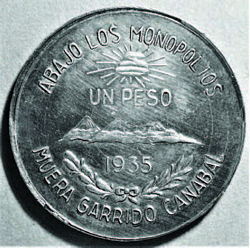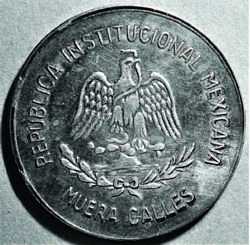The 1935 Tabasco Muera Calles 1 Peso — Political Propaganda, or the Real Thing?
by David Hughes


The Tabasco 1935 Muera Calles/Muera Garrido Canabal Peso, in (low-grade?) silver. Similarities to the later 20 centavos design include the Liberty Cap with rays, above, the denomination under the Liberty Cap, the volcanoes, and the date under. The two different leaf sets in the wreath are replaced with two different cacti plants on the 20 centavos..
The Mexican bronze 20 centavos of 1943-1974 is a bold design resulting in an attractive coin. Elements of the 20 centavos’ design, possibly used in the final product, appear on an earlier issue, the 1935 Tabasco Muera Calles/Muera Garrido Canabal 1 Peso. Is this piece political propaganda, or the real issue of a Revolutionary faction? Carlos Gaytan (1969) Carlos Gaytan, La Revolución Mexicana y sus Monedas, Mexico City, Mexico, 1969 included it in his Revolutionary coin catalogue, noted as rare.
Plutarco Elías Calles, perhaps as brutal a ruler as Mexico needed at that time after the Revolution, was the Mexican President from 1924 to 1928. A radical anti-Catholic, he implemented and added to the anti-clerical sections in the 1917 Constitution which had been politely ignored by his predecessor, Alvaro Obregón. This resulted in the 1926-1929 Cristeros war, pitting local Catholics against Federal forces, with excesses on both sides, mostly in central-western Mexico. It was noted that the Federal army was in no real hurry to defeat the rebels, treating it more like a training
exercise, and coming out with a lot of spoil.
In 1928, Alvaro Obregón, the President-elect, was shot and killed. Calles, the sitting President, could not continue as President, as, among other reasons, íNo Reeelección! was fought over during the Revolution and enshrined in the 1917 Constitution.
Calles announced his “retirement”, resulting in a string of provisional presidents, directed by the dour ex-president. He led from behind, so to speak, from the comforts of Cuernavaca, Morelos, on what became known as the “Street of the Forty Thieves”, the (self-described) Jefe Maximo, the Maximum Chief of the Revolution. The rabid radical Governor of the southern state of Tabasco, Garrido Canabal, legislated (dictated) against the church and empowered a group of thugs known as the “Red Shirts” who attacked church goers and church property, to the point of knocking crosses off of tombs and tearing out and burning the images of the saints.
The 1934 Mexico Presidential election was the first regular election after the assassination of Obregón. The official Partido Nacional Revolucionario (PNR) candidate, the amazingly honest Lázaro Cárdenas, campaigned like he was in a heated contest, traveling the country, meeting the people. One history I have consulted notes there was an anti-Callista candidate who also ran, as well as a communist (Fehrenback, 1995). Cardenas was subsequently elected by an overwhelming “official” majority. Calles assumed he would continue pulling the strings of puppets, as President Cárdenas found his Cabinet already appointed and installed, including Garrido Canabal as Secretary of Agriculture, when he entered office on 1 December 1934.
It seems reasonable to place the 1935 Tabasco Peso in this time and place. It appears in (low grade?) silver and copper at the same diameter as the current 0.720 fine silver Federal peso. It was not the first death threat on a Mexican coin, but inspired by the famous 1914 Muera Huerta (Death to Huerta) 1 peso. And the inscriptions? República Institucional Mexicana (The Institutional Mexican Republic), sarcasm directed at the ruling institution of the PNR? Abajo Los Monopolios (Down with the Monopolies), down with the monopoly of the PNR on political power? It appears a product of the results of the Revolution. Some authors call the peso a Cristeros issue, and the Cristeros, though defeated, were bitter and resentful, so it could be possible. My readings of various histories do not suggest an alternative group.
President Cárdenas tolerated this nonsense for a month or so, then fired the Calles appointees, including Garrido Canabal, who was exiled to Costa Rica. After Calles sputtered and protested, the ex-president was placed on an airplane pointed north and told not to come back. Cárdenas’ presidential campaign resulted in building his power base of personal connections, and the nation was ready to move on. Anti-clerical laws remained on the books, but they were softened and only selectively enforced.
.
